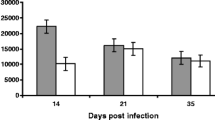Abstract
In all, 2 groups of lambs were infected either with Oestrus ovis first-instar larvae or with 10,000 third-stage larvae (L3) of Haemonchus contortus. Another group of lambs was infected with both parasites. Fecal nematode egg counts, plasma pepsinogen concentrations, specific O. ovis enzyme-linked immunosorbent assay (ELISA) antibodies, and blood eosinophil counts were monitored and compared to with the values recorded for a control group of uninfected lambs. There was no significant difference between the burden of H. contortus found in mixed and single infections. However, the nematode egg production was significantly depressed in mixed infections. O. ovis affects the population of H. contortus at least by decreasing the parasite egg output. This effect may be mediated through the increase in eosinophil production stimulated by the presence of O. ovis.
Similar content being viewed by others
Author information
Authors and Affiliations
Additional information
Received: 24 January 1997 / Accepted: 13 February 1997
Rights and permissions
About this article
Cite this article
Dorchies, P., Bergeaud, J., Khanh, N. et al. Reduced egg counts in mixed infections with Oestrus ovis and Haemonchus contortus : influence of eosinophils?. Parasitol Res 83, 727–730 (1997). https://doi.org/10.1007/s004360050328
Issue Date:
DOI: https://doi.org/10.1007/s004360050328




